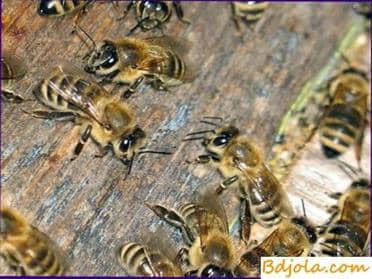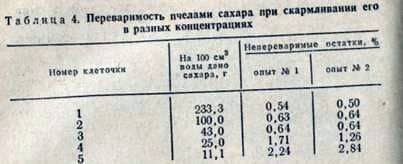
Bees are small insects, and therefore it is not possible to determine from them the digestibility of feed by the method commonly used in animal husbandry. In addition, the bee honey taken can not be considered eaten, since the bee in honey crab can store it for a long time. Bees under normal conditions excrete feces only during the flight, therefore it is impossible to accurately collect and take into account it. All these difficulties required the development of a special method for determining the digestibility of feed by bees.
To determine the digestibility of honey, bees are placed in cells measuring 20X8X15 cm having a mesh front wall, a retracting posterior and three holes in the lid: one for the cell with the uterus (with the bee sitting more calmly), the other for the jar with feed and the third for the tube with water. 50 g of bees are placed in a box, previously kept without flying out in a cool room, so that they consume all the honey that was present in honey cinders. The absence of honey in zobics is established by opening several bees.
When settling cells, take an average sample of 500-600 bees, which are accurately weighed, then counted to determine the average weight of one bee. These bees determine the stool content in the hindgut at the beginning of the experiment. The hindquarters are gently removed from the abdomen of a decapitated bee, after which it is weighed together with feces on an analytical balance. Further guts with feces are dried, brought to constant weight and weighed again.
Cells with a precisely known number of bees are placed in a thermostat at a temperature of 32 њ C and supplied with the food under study. To examine each sample of honey take three cells. As a control, three more cells are isolated with bees, which are given a pure sugar syrup of precisely known concentration.
After five days, the feeding troughs are selected and the bees are again kept until the honey disappears in honey cinders. The remaining feed is weighed and the amount of food eaten during the period of the experiment is determined. All bees extract the hindgut and determine the amount of feces that accumulated at the end of the experiment. To do this, we weigh the hindquarters with feces, after which they are dried to constant weight and weighed again. Calculate the entire mass of feces, isolated by the bees of each cell, make an amendment to the bees that died during the experiment.
Now the researcher has all the data necessary to determine the digestibility of honey bees by the bees. Knowing the concentration of food (honey, sugar), calculate the amount of sugar eaten by bees in a dry mass. Determine the dry mass of feces of all the bees before the experiment and after the experiment, calculate the total amount of stool (in dry mass) formed from the eaten food. Next, calculate the amount of feces formed per 100 g of eaten food (dry weight). This is the rate of digestibility of feed in percents. Since the digestibility of honey and sugar by bees is very large, it is more convenient to use the reciprocal quantity – the amount of indigestible residues.
The intensity of metabolism in bees largely depends on the external conditions, which should change and digestibility of feeds, so methodical experiments were conducted to study the digestibility of bees honey and sugar in different conditions (Table 4).

As can be seen from Table 4, at high concentrations of sugar syrup, the digestibility of sugar is very high: it gives indigestible residues from 0.50 to 0.64%. At low sugar concentrations, bees can not completely satisfy their need for food and consume part of the nutrient reserves of their body. Due to the decay products of these substances, the contents of the hindbones and the amount of indigestible remains increase in bees.
At the accepted concentrations of sugar in the feeding of bees (100-150 g of sugar in 100 cm3 of water), indigestible residues amount to 0.64%.
Experiments have shown that with decreasing temperature, the amount of indigestible residues decreases slightly. The most stable indicators were obtained with the content of bees at a temperature of 32-33 њ C.
To determine the digestibility of honey, two samples were taken: flower honey collected from mixed herbs, and honey with a admixture of padi on which the bees did not overwinter well (Table 5).

When feeding bees, a sample of flower honey was formed 3 times as much as feces than with pure sugar. Honey containing an admixture of padi gave significantly more indigestible residues. However, this increase is small, and they can not explain the appearance of diarrhea in bees during the winter.
The increased amount of indigestible residues in bees fed with honey (compared to sugar) is explained by the fact that honey contains, in addition to sugars, other substances (dextrins, impurity pollen, etc.) not fully absorbed by bees.
Как крепить вощину к рамкам. Лечебные травы и мед.
Feeding base of beekeeping